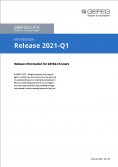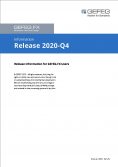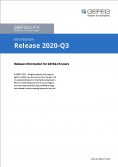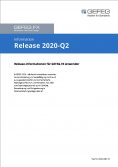At the end of 2020, the World Customs Organization released a new version of its Data Model. GEFEG.FX users of the WCO Data Model version 3.10 can now access the new version. What is new in 3.10? Requirements due to new or amended legislation submitted as change requests by customs authorities and WCO Data Model users have been added or have been modified.
The involvement of customs authorities from around the world supports an important objective of the data model: Requirements of national and regional legislations or guidelines for implementation are considered and incorporated in the WCO Data Model. There is no new information package in this version, so that the new version is backward compatible. Extensive changes are expected in the next major version of the WCO Data Model. As it currently stands, this major version is expected to be released towards the end of 2022.
Effectiveness and efficiency of customs authorities around the globe will be improved
It is an important objective for the WCO Data Model to create and further develop a global standard for seamless crossborder transactions for all customs administrations worldwide. What are the benefits of the data model, which is intended to be the basis for information exchange of crossborder processes in a global world?
The data model opens the possibility to achieve interoperability and collaboration in single window and other implementations by customs authorities. Data flow and integration of business data for customs procedures should be simplified and harmonized. The main components of the WCO data model consist of “Base Information Packages.” These information packages compile information that is submitted by economic parties and processed by customs for typical customs processes and procedures in single window implementations or at the virtual border. This includes, for example, declarations, licenses, permits, certificates, or other types of regulatory cross-border trade documents.
Delivery of the WCO Data Model in a structured, reusable format in GEFEG.FX
In cooperation with the World Customs Organization, GEFEG has been delivering the WCO Data Model with GEFEG.FX software since the early 2010s. Thus, new possibilities for joint development work and user-specific use of the WCO Data Model opened up for Customs authorities, governmental organizations, traders and other parties involved in cross-border processes. For users, the reuse of the WCO data model is simplified and streamlined with GEFEG.FX. A ready-to-use XML schema export also contributes to this.
Easy and effective use of the WCO Data Model
Many users of the WCO data model packages in GEFEG.FX have been impressed by the simple and efficient methods for reusing the WCO data model and planning their country-specific policies. With each new release, it is important for users to determine if their existing implementations need to be modified to incorporate the latest WCO definitions of objects and customs procedures to ensure compliance with the Data Model. In this release, there are 11 new Compositions, 2 new Attributes, 3 new Classes, and 1 new Code List that are being maintained and approved by the WCO’s Data Model Project Team and applied in GEFEG.FX by GEFEG’s Implementation Support Team.



